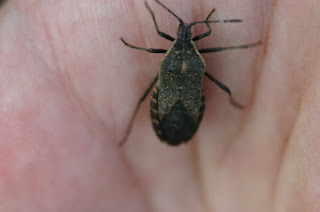

Over the last several weeks, the young gardeners have become scientists. They have been curious, creative and open minded. They have formed hypothesis and conducted experiments. They have been careful observers, and have kept good records of rainfall, soil and weather conditions and the height of the lasagna garden.
Today the young scientists learned about jobs available to those with a horticulture background: research scientist, garden writer, greenhouse manager, teacher, florist, peace corp volunteer are just a few. They were encouraged to think about 'green jobs' in the industry.

We asked the budding scientists what they liked the best about their Garden N Grow experience. Here are their answers:
Tosh - squishing bugs
Ethan - planting the garden
Garrett - taking home produce
Tyler liked the lessons
Caitlyn liked tasting basil
Reilly loved the pickled okra
Anna liked picking produce. She also liked when the snack was the lesson and the lesson was the snack!
Bridgette liked eating the fried okra her grandmother made with the produce she brought home.
Before we parted, the young gardeners made thank you cards for the good people of Fairview Christian church, without whose kind generosity this session of Garden N Grow would not have been possible.

It was a tough year for the garden, unusually hot and dry. In an organic garden pests are always a challenge, but the weather this summer made it more difficult than usual. Our squash failed early (squash vine borer), and flea beetles got to our beans. And of course there was the very cool tobacco horn worm. There could have been a tomato horn worm as well (very subtle difference, and they do the same damage). Still the young gardeners were able to take home some harvest. Here are this year's totals:
Tomato 7.7 lbs
Peppers 6.45 lbs
Squash 0.0 lbs
Beans 0.1 lbs
okra 17.8 lbs!!!
cucumbers 6.4 lbs
onions 0.1 lbs
herbs 3.2 lbs










































